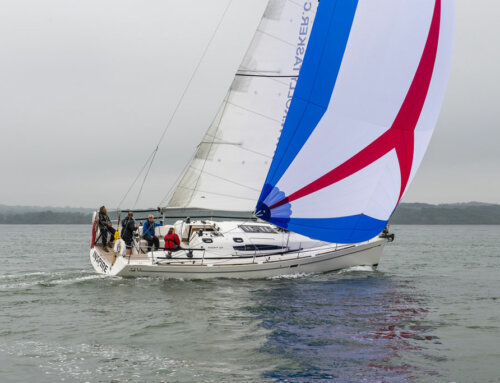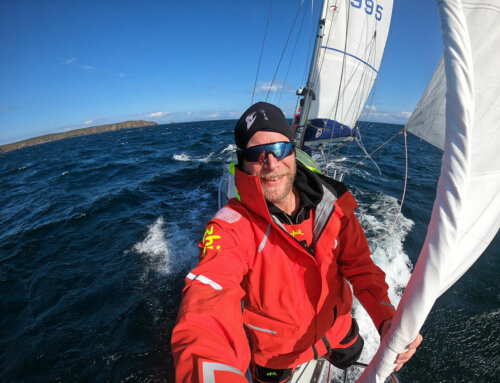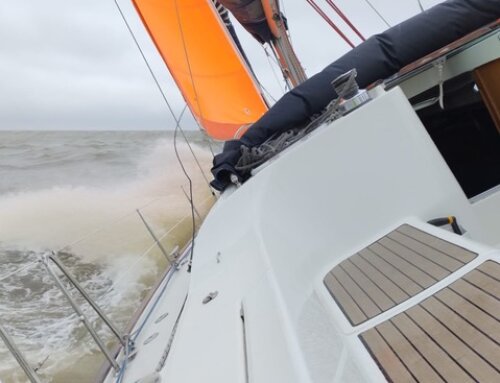A complete set of storm sails – storm jib and storm trysail – are mandatory for ocean racing yachts under the international racing rules and this for very good reasons. And these same reasons also are good for any cruising yacht than ventures beyond coastal waters.
Heavy Weather Coastal
In coastal waters, a Rolly Tasker Offshore standard mainsail with two or three reefs and a heavy number 3 or number 4 jib should be a good sail-plan for strong winds (up to or around 30 knots of windspeed) or maybe even storm conditions (30 knots plus). But do bear in mind that every sail will suffer when it is used in extreme conditions for which it has not been designed.
Standard sails are normally made of light material and not specifically for heavy weather, as these conditions will be the exception in average coastal sailing. A Genoa will also usually be designed for light to medium winds. In heavy winds, these sails will lose their optimum shape. Especially a reefed, partly furled Genoa can become baggy, which causes excessive heeling and poor performance.
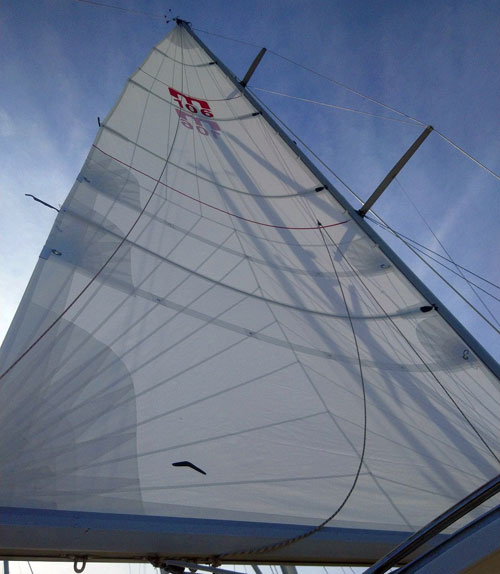
Offshore and Ocean Sailing
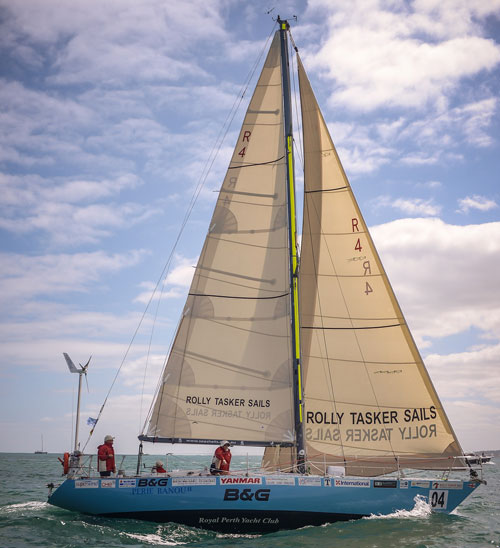
When we refer to storm conditions in the following paragraphs, we are talking about 35 to 40-knot plus winds in the open ocean.
Rolly Tasker Offshore sails are well suited for winds of up to 30 knots and above. These sails are designed for Ocean sailing and made of heavy cloth. For extra strength, they can also be specified with a double leech, a “twin ply leech”, which will make these sails strong enough also for storm conditions. The multiple round-the-world sailor Jon Sanders for example uses a Rolly Tasker Offshore mainsail with three reefs, of which the third reef is high up in the sail. Triple reefed, Jon Sanders uses his main also in storm conditions. He still carries a trysail (see below) on board for easier handling in even more extreme conditions.
Better balance and more safety with storm sails
Being designed and made for tough conditions, storm sails will set better, perform better and be stronger and thus safer than deeply reefed sails. Especially if the storm jib is set on a dedicated inner forestay, the sail configuration of storm jib and trysail will concentrate the centre of effort in the middle of the boat. This gives better balance and enhanced maneuverability which might be crucial, depending on situation and your storm tactics. Alternatively, storm sails are small and strong enough to lay hove-to even in very bad conditions.
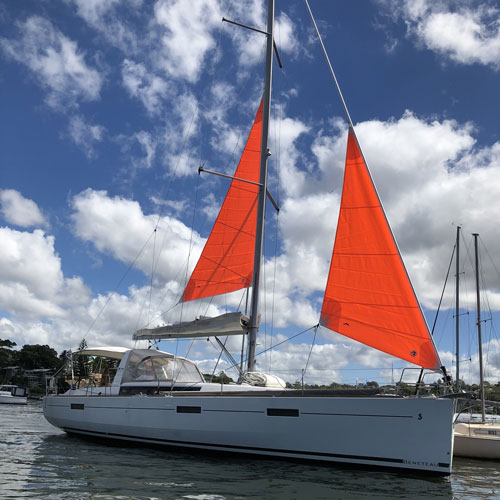

The trysail
The trysail is much stronger than a deep reefed mainsail, assuming that your mainsail has three reefs at all as opposed to the usual two reefs. If it is taken down and lashed to the boom in severe weather, your mainsail will of course also last longer. The trysail does not need to be attached to the boom, which takes much of the horror out of heavy weather gybing. However, Lazy Jacks interfere with tacking or gybing a trysail and should be taken forward and lashed to the mast. The sheets of the trysail are usually led well aft, often to mooring cleats on the aft deck. A block or snatch block will then take the sheet to a winch. Once properly set, the trysail will be the best sail in heavy conditions. The trysail steadies the yacht and also gives good drive.
How to set the trysail
The trysail is set above the boom and the lashed main. A tack pennant will bring it to the correct height which depends on the height of the boom, but also the chosen sheeting point. Hoist the trysail in harbour with the sheet attached to the chosen sheeting point, then belay the halyard when the sheeting angle is right, and pull the luff tight with a tack pennant. Finally, permanently attach the tack pennant to the sail so that you will automatically set the sail at the correct height when using it in anger.
Setting a trysail in real storm conditions can be difficult. This is made much easier it there is a second, dedicated mast track running parallel to the mainsail track on the mast and again still easier if the trysail track comes down right to the deck. This in turn makes it possible to keep the trysail permanently bent on and stowed in its bag at the foot of the mast. This solution is good practice on any blue-water yacht that regularly sets off on long ocean passages. The bag can have drain holes in the bottom to let water run out. But this is the easiest and safest way of setting the trysail in storm conditions: put on the halyard and hoist away.
Alternatively, the trysail can be set in the mainsail track, or with parrel beads around the mast. Another option is to fix the main halyard to the gooseneck fitting of the boom and then winching this as tight as possible. The halyard will now act as a temporary stay on the aft side of the mast. The trysail can be hanked on to the halyard and hoisted with, for example, the topping lift of the boom as a new halyard. This setup saves feeding the luff of the trysail into the mast groove.
Finally, the trysail also is a very useful emergency back-up, should either the mainsail or the boom be damaged or broken in mid-ocean.
The storm jib
For offshore yachts, a storm jib is considered by many as even more essential, especially with a roller furling headsail setup. Many boats have a fairly large Genoa permanently set on the roller gear. However, a sail that has been designed for light to moderate breezes will be more or less useless in a blow of 30 or 40 knots. The shape is not any good at all when reefed to the small size adequate for this wind strength. Also, the cloth itself will be too light, bringing the sail even more out of shape.
For cruising yachts that normally do more coastal cruising, a storm jib one or two sizes up from the standard specification will make a very useful heavy weather foresail, in lieu of the heavy number 4 foresail.
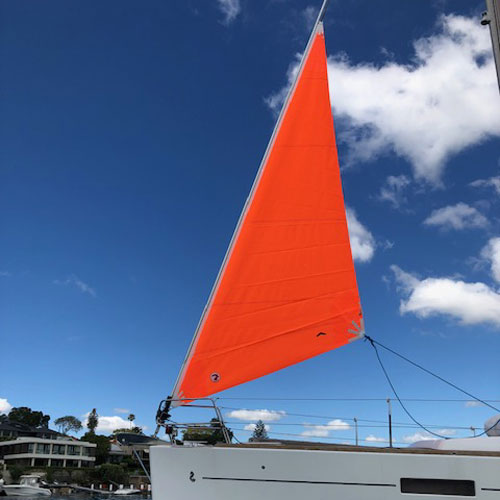
The Gale Sail
The best solution for these roller furling headsails is our specially made storm jib on a loose sleeve that comfortably slides over the completely furled foresail: The Gale Sail. This is much better in every way – shape, stability, reliability, and aerodynamic efficiency. It also offers an additional safeguard to keep the large headsail securely furled – imagine the chaos, damage and danger should a big sail be torn open by a 40-knot wind and unfurl by itself!

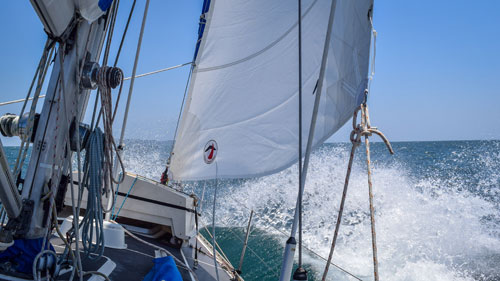
Dedicated inner forestay
Another alternative is a separate, inner stay for hanking on the storm jib. Again, this is efficient, safe and easy. If the yacht is cutter rigged, this inner stay will be permanently rigged. Some sloop configurations also allow a separate inner stay to be set up with a strong point on deck and a tensioning lever when it becomes necessary. It is also possible to rig up permanent or temporary textile stays.
Sheeting angle
The sheeting position for the storm jib can be adjusted by hosting or lowering the sail on the forestay. Once the best height of the sail that gives the proper sheeting angle is determined, fix a pennant to the tack of the sail, this will then again ensure the sail is set at the right height.
Check it out!
Please do set up and check fastenings, sheeting angles and positions and other considerations for your storm sails at your leisure in harbour, and preferably in light weather, before setting out to cross the next ocean!

